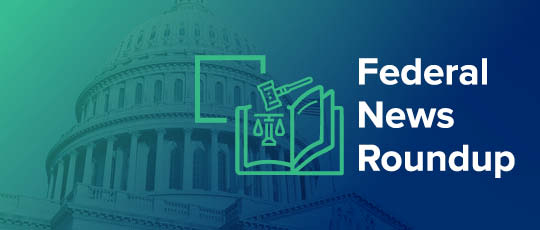- Monthly BLS Jobs Data Delayed, But Other Reports Shed Insight
- Florida, Canada Raise Minimum Wage Rates
- Lawsuit Filed Challenging Trump's $100,000 Fee for H-1B Worker Visas
- Nebraska Paid Sick Time Law Goes into Effect
- Alaska Issues Final Regulations for Paid Sick Leave
- Democratic Lawmakers Propose Universal Paid Leave Act
- Starbucks Closes Stores, Leading to 900 Job Cuts
Monthly BLS Jobs Data Delayed, But Other Reports Shed Insight
The monthly U.S. jobs report, which was scheduled to be released on Friday, Oct. 3., by the U.S. Department of Labor’s Bureau of Labor Statistics (BLS), was delayed because of the current federal government shutdown. However, a couple of other job-related reports provide a snapshot of the American labor market.
According to estimates published Thursday, Oct. 2, by financial data firm FactSet, the economy added 50,000 jobs in September, better than August’s preliminary 22,000 gain but well below the trailing 12-month average of 123,900. The unemployment rate held steady at 4.3% but remained below the trailing 12-month average of 4.2%. Wage growth and the average workweek were expected to be unchanged from August, when pay gains rose 0.3% monthly and 3.7% annually, and the average workweek was 34.2 hours.
The Job Openings and Labor Turnover Summary (JOLTS) report, released Tuesday, Sept. 30, by the BLS, showed the number of job openings was unchanged at 7.2 million in August. Over the month, both hires and total separations were little changed at 5.1 million. Within separations, both quits (3.1 million) and layoffs and discharges (1.7 million) were little changed.
This release includes estimates of the number and rate of job openings, hires and separations for the total nonfarm sector, by industry, and by establishment size class. Job openings include all positions that are open on the last business day of the month. Hires and separations include all changes to the payroll during the entire month.
Florida, Canada Raise Minimum Wage Rates
Effective Sept. 30, the minimum wage for workers in the state of Florida increased to $14 per hour.
The hike comes after Florida voters approved Amendment 2 in 2020, which amended Florida’s constitution to gradually increase the state’s minimum wage to $15 an hour by the year 2026. The next pay increase on Sept. 30, 2026, is scheduled to be the last minimum wage hike.
Prior to the passage of Amendment 2, the state’s minimum wage was $8.46.
In Canada, five provinces implemented minimum wage increases starting on Oct. 1. As outlined by Littler employment law firm:
- Ontario’s general minimum wage increased from $17.20 to $17.60 per hour. The hike applies to most employees in the province, whether they are full-time, part-time or casual employees, and regardless of whether they are paid on an hourly, salaried, commissioned or other basis.
- Manitoba’s provincial minimum wage increased from $15.80 to $16. This increase corresponds to Manitoba’s 2024 inflation rate of 1.1%, rounded up to the nearest increment of 5 cents.
- Nova Scotia’s provincial minimum wage increased from $15.70 to $16.50 per hour. This is the province’s second minimum wage increase in 2025. The Nova Scotia government updates the minimum wage every April 1, using the previous year’s Consumer Price Index as a benchmark and adding an extra 1%. This year, it introduced an additional increase on Oct. 1 to respond to growing concerns about the rising cost of living.
- Prince Edward Island’s provincial minimum wage increased from $16 to $16.50. Each year, the Prince Edward Island Employment Standards Board reviews the province’s Minimum Wage Order and assesses whether it ought to be changed.
- Saskatchewan’s provincial minimum wage rose from $15 to $15.35. The Saskatchewan government calculates its minimum wage using an indexing formula that gives equal weight to changes in the Consumer Price Index and the province’s average hourly wage.
Lawsuit Filed Challenging Trump's $100,000 Fee for H-1B Worker Visas
As reported by Reuters, a coalition of unions, employers and religious groups filed a lawsuit on Friday, Oct. 3 seeking to block President Donald Trump's bid to impose a $100,000 fee on new H-1B visas for high-skilled foreign workers. The lawsuit filed in federal court in San Francisco is the first to challenge Trump's proclamation issued last month announcing the fee.
The United Auto Workers union, American Association of University Professors and other plaintiffs say Trump's power to restrict the entry of certain foreign nationals does not allow him to override the law that created the H-1B visa program. The program allows U.S. employers to hire foreign workers in specialty fields; technology companies in particular rely heavily on these workers.
Employers who sponsor H-1B workers currently typically pay between $2,000 and $5,000 in fees, depending on the size of the company and other factors, according to the Reuters report. Trump's order bars new H-1B recipients from entering the United States unless the employer sponsoring their visa has made an additional $100,000 payment.
Nebraska Paid Sick Time Law Goes into Effect
Nebraska employers must now allow employees to earn and use up to 40 or 56 hours of paid sick time per benefit year, depending on employer size.
In November 2024, Nebraska voters adopted a paid sick time ballot initiative that called for a paid sick time law to go into effect Oct. 1, 2025. The law, known as the Nebraska Healthy Families and Workplace Act, only applies to employers with 11 or more employees, according to legal experts at Seyfarth Shaw LLP. While the law allows for reduced paid sick time obligations for “small businesses,” the threshold to qualify is employing fewer than 20 employees.
Employees who have worked at least 80 hours in Nebraska are eligible for paid sick time, regardless of whether they are full time, part time or temporary. Exemptions include individual owner-operators, independent contractors, seasonal or temporary agricultural workers, and workers under the age of 16.
Under the law, employers:
- Must pay employees for used sick time at the same hourly rate as the employee typically earns during hours worked.
- Can use available paid sick time (a) for their own or a covered family member’s illness, injury or health condition, including preventive medical care; (b) to attend a meeting at the employee’s child’s school or place of care dictated by the child's mental or physical illness, injury or health condition; or (c) certain public health emergency-related absences.
Alaska Issues Final Regulations for Paid Sick Leave
The Alaska Department of Labor and Workforce Development published its final rules implementing paid sick leave provisions. Although the state’s new law took effect July 1, there was a public comment period through July 31 before the proposed regulations were finalized Sept. 25.
According to legal experts at Littler, notable changes to the final rules include:
- Different standards apply depending on whether an employer has 15 or more, or 14 or fewer, employees. The final rule uses “full-time equivalents (FTEs)” rather than “employees.”
- The department requires calculating the “regular” rate of pay for overtime purposes when determining how much to pay employees when they use paid sick leave. But for employees who work at two or more rates, the department now allows both the previously proposed “weighted average” method (for the workweek) and the “rate in effect” method (for the shift).
- A new rule defines a “year” for compliance purposes. It requires an employer to establish a “year” as a consecutive 52-week period. If it does not, the default year is the calendar year.
- The final rules scrap a proposal to define a “full day” as not more than eight hours, thereby allowing an employee to receive “full” payment when they use paid sick leave on a day that would include working more than eight hours, and an employer to deduct from an employee’s leave bank more than eight hours of leave for such an absence.
Democratic Lawmakers Propose Universal Paid Leave Act
On Sept. 16, U.S. Sen. Kirsten Gillibrand (D-New York) and U.S. Rep. Rosa DeLauro (D-Connecticut) introduced the Family and Medical Insurance Leave (FAMILY) Act . The bill aims to guarantee up to 12 weeks of partial income for workers who have to take leave for serious medical and family events.
The FAMILY Act would provide workers with paid leave for a range of major life events, including:
- Recovering from their own serious health condition;
- Caring for a family member with a serious health condition;
- Bonding with a new child — whether newborn, adopted or placed through foster care;
- Handling responsibilities related to a family member’s military deployment; and,
- Taking “safe leave” to respond to domestic violence, sexual assault or stalking.
Gillibrand and DeLauro first introduced the bill in 2013. The latest version also would create a dedicated trust fund to pay out benefits, rather than funding the program through payroll contributions.
In addition, several employers, including Levi Strauss & Co., Patagonia and Etsy, signed a letter to members of Congress in support of the legislation.
Starbucks Closes Stores, Leading to 900 Job Cuts
As reported by the Associated Press, Starbucks announced Sept. 25 it was closing hundreds of stores in the U.S., Canada and Europe and laying off 900 nonretail employees.
The store closures were effective immediately, and Starbucks said it would offer affected baristas severance packages and transfers to other locations where possible.
The coffee chain didn’t share the number of stores that closed, but the bulk of them appeared to be in the U.S. and Canada. Starbucks said it expects to have 18,300 North American locations when its fiscal year ends.
The company also said it expects to spend $1 billion on the restructuring, including $150 million on employee separation benefits and $850 million related to the physical store closing and the cost of exiting leases.
This is the second round of layoffs at Starbucks this year. In February, 1,100 global corporate employees were let go and several hundred open positions were eliminated.
Editor’s Note: Additional Content
For more information and resources related to this article, see the pages below, which offer quick access to all WorldatWork content on these topics:
#1 Total Rewards & Comp Newsletter
Subscribe to Workspan Weekly and always get the latest news on compensation and Total Rewards delivered directly to you. Never miss another update on the newest regulations, court decisions, state laws and trends in the field.








